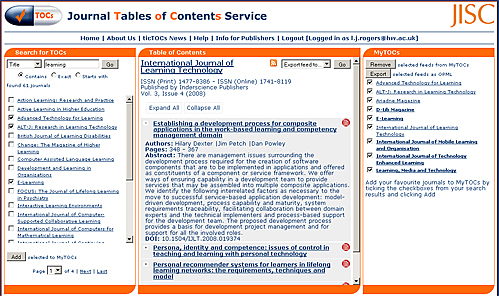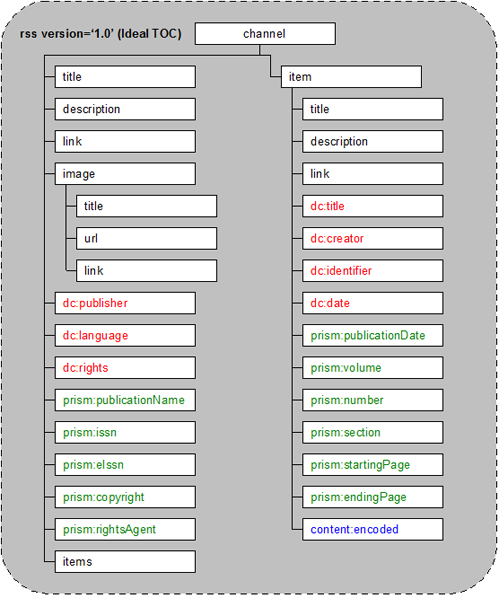RSS and Scholarly Journal Tables of Contents: the ticTOCs Project, and Good Practice Guidelines for Publishers
Written by Lisa Rogers.
RSS feeds enable frequently updated content to be delivered efficiently to users. Users can ‘subscribe' to feeds, where available from their favourite websites, and subsequently be alerted, through whichever feed reader they choose to use, whenever new material is available. RSS is therefore an effective sharing mechanism, as the content, or more often a brief summary of content, is delivered to users as and when they want to receive it. Normally associated with news articles and blog updates, RSS can be used to share many different types of information, such as:
- Text (website updates, job adverts, events, calls for papers, etc. (1))
- Images (known as image streams, i.e. from Flickr)
- Audio (known as podcasts, i.e. radio shows, language learning, etc.)
- Video (also known as podcasts, or even vodcasts, i.e. lecturers sharing videos of their lectures)
- Learning Objects, (i.e. from Jorum (2))
A growing number of scholarly journal publishers provide RSS feeds for their Tables of Contents (TOCs). It is possible to subscribe to these feeds in order to get the most up-to-date tables of contents for a particular journal or journals. Subscribing to a feed enables someone to not only read the latest TOC, but also to share and re-use the information by publishing it to their blog or adding it as a widget to their website.
In theory, therefore, anyone can keep fully up-to-date with all the scholarly journals they want. However, as I have found from my work on the ticTOCs project, it isn't always that easy.
ticTOCs Project
The ticTOCs project (3) consists of a consortium of 14 partners (University of Liverpool, Heriot-Watt University, Cranfield University, CrossRef, ProQuest, RefWorks, Emerald, SAGE Publishers, Institute of Physics, Inderscience Publishers, MIMAS, Directory of Open Access Journals, Open J-Gate and Intute). It is developing and piloting a free service where academics, researchers and anyone else can easily keep up-to-date with scholarly journal Tables of Contents (TOCs).
ticTOCs has gathered over 10,000 TOC RSS feeds from over 300 large, medium and small publishers, and has created a searchable directory of the latest Tables of Contents to enable users to search, browse, view and subscribe to TOCs, without needing to be familiar with the concept of RSS. Users can also find TOC feeds for many journals that they are interested in, without having to search numerous different publishers' websites.

Fig 1. Screenshot of ticTOCs
Why ticTOCs?
In 2007, Hardesty and Sugarman (4) conducted a survey on the methods that librarians used to keep up-to date with professional literature, and found that only 15% of those surveyed used RSS feeds as a mechanism for current awareness. The take-up of RSS feeds has, in general, been very low. Barr (5) reported that this may be due to many potential users not having heard of the technology or being intimidated by it. ticTOCs bypasses this problem by allowing users to view TOC feeds in a consistent format, without the need for a separate feed reader. Users can also, however, export selected TOC RSS feeds to their own feed reader, if they so wish.
Where are the feeds?
The first challenge faced by ticTOCs was identifying TOC RSS feeds. We knew that many publishers provided feeds, but where were they? Did the publishers provide a single list of all their feeds, or were they on individual journal home pages? Were they hidden away in some obscure page on the website, or perhaps they were only available to users who registered with the publisher or service? The preferred option for the ticTOCs project is that publishers provide a list of their feeds in an OPML file, an XML list of the location of all the RSS feeds on the site.
It is important that users should also be able to quickly and easily find feeds on a publisher's website. Ideally they should be able to find an RSS feed both from each journal homepage as well as, perhaps, on a page listing all the RSS feeds that a publisher provides. ticTOCs recommends not restricting access to TOC RSS feeds in any way. RSS is an excellent and cost-effective way of driving traffic to, and increasing brand awareness of publishers' content. Restricting access to the feeds themselves (e.g. to subscribers only) negates many of the potential benefits that RSS can bring to both publishers and users.
We have also found that the URLs for feeds vary enormously. Some publishers add ‘/rss/' onto the end of the URL for the journal. Others dynamically create RSS feeds, and yet more create a unique URL in order to track who is using the feeds.
What feeds are publishers providing?
As ticTOCs is a current awareness table of contents service, we are only interested in RSS feeds for the latest tables of contents. However, we have found many variations of what is contained in the feeds - from the latest Tables of Contents, to the last 20 articles published, to articles in print, and even the entire back catalogue of all articles ever published for a journal! Some publishers do, however, provide a range of different feeds to allow users to select which one best suits their needs.
Publishers are using various versions of feeds such as RSS 1.0, RSS 2.0, RSS 0.91 and Atom. RSS 0.91 and RSS 2.0 are very simple XML formats, and typically only contain the fields for title, description and link. However, RSS 1.0 can easily be extended by the use of modules so as to not only deliver the content, but also provide structured metadata. One such module for extended RSS 1.0 is the Publishing Requirements for Industry Standard Metadata (PRISM) module. A variety of publishers such as Nature Publishing Group (6), Inderscience (7) and SAGE (8) are already using PRISM along with Dublin Core Metadata to provide rich metadata in their RSS feeds.
Another module that is often used in RSS 1.0 feeds is the content:encoded module, which allows feed providers to mark up their text with HTML tags or add additional content such as images. The Royal Society of Chemistry (9) has made use of this module in order to provide additional diagrams within feeds.
Valid feeds
It is good practice to ensure that feeds are valid. This will benefit users as an invalid feed may be totally unreadable, have bad encoding or important information may be missing. A valid feed will work in the widest variety of feed readers and other RSS tools. Common mistakes are mixing elements from the different versions of RSS, not using the correct character encoding or missing key elements such as .
Many providers of RSS feeds use html tags within their feeds to try and control how they are displayed. However, many feed readers often strip out html tags, and important information can consequently be lost. If publishers want to try and control the display of a feed, they can use the content:encoded module to do so, whilst displaying plain text only in the description element.
Additional Functionality
An additional feature of the ticTOCs service is the export to RefWorks (10) facility which allows users to import the reference for an article into the RefWorks reference management system. The quality of the reference is obviously dependent on the quality of the metadata provided by the RSS feed, therefore references from publishers who provide additional metadata using RSS 1.0 together with PRISM and Dublin Core will provide fuller references from ticTOCs than publishers who don't.
Guidelines for Publishers
Gathering feeds for the ticTOCs project has a raised a number of important issues relating to inconsistencies in the provision of RSS feeds by publishers. An RSS Working Group has been set up to discuss these issues and to draw up guidelines for publishers wishing to provide RSS Feeds for journal tables of contents. Representatives from CrossRef, Nature Publishing Group and ticTOCs are participating in the working group. Some of the proposed guidelines are:
- Use the RSS 1.0 specification because of its greater flexibility. RSS 1.0 extended with RSS 1.0 modules is ideally suited to the provision of RSS table of contents type materials. A number of publishers are already utilising this approach. Some publishers offer a choice of formats for their TOCs (e.g. RSS 1.0 and RSS 2.0).
- Use RSS 1.0 Modules (e.g. Dublin Core Module, CONTENT Module and PRISM Module) to extend TOC RSS feed functionality.
- Use RSS 1.0 Syndication Module to describe how often the content is updated (useful for machine to machine interfaces as to how often to check for new content).
- Validate TOC RSS feeds using an RSS validation tool (e.g.W3C feed Validator (11) or Redland RSS 1.0 validator (12)).
- Do not include HTML mark up in standard RSS Feed elements (e.g. Avoid using HTML tags (such as <b> </b> </a> <p> <b> <a> etc) in the <item> <description> </description> </item> </a> <a class=""> etc) in the <item> <description> element. The <item> <description> should only include plain text as it is not possible to know how the feed will be presented, and including HTML mark up can prevent your feed from being correctly displayed).
- Use the RSS 1.0 Content Module to present HTML marked up content. For example, the <content:encoded> element can be used to provide an alternative marked up versions of the <item] <description>
- Do not restrict access to TOC RSS feeds. RSS is an excellent and cost-effective way of driving traffic to, and increasing brand awareness of publishers' content. Restricting access to the feeds themselves (e.g. to subscribers only) negates many of the potential benefits that RSS can bring.
- Produce regular static copies of RSS feeds rather than generating them dynamically for the end user. Dynamically generated feeds can be slow to appear and can cause time out problems. This can affect feed availability, feed validation services and third parties who wish to aggregate feed content.
- Understand the purpose of each RSS TOC feed you provide. Provide multiple feeds, rather than diluting the message of one with information irrelevant to its audience. For example, it may be appropriate to provide separate feeds for the current TOC issue only and a combined TOC for a number of recent issues.
- Ensure your web server is configured to serve RSS files using a mime type of text/xml
- Provide OPML files to enable aggregators or end users to utilise a number of your feeds. In some instances it may be appropriate to provide a range of OPML files (e.g. OPML files for each subject category) or to enable end users to create custom OPML files on the fly.
Fig 2. is a diagram suggesting the Use of RSS 1.0 with the addition of PRISM, Dublin Core and Content Modules. The diagram illustrates useful elements to include such as ISSN, Volume, Number and Page Numbers.

Fig 2. An Ideal TOC feed
References
(1) MacLeod RA (2007) ‘RSS Update: It's RSS, Jim, but Not as We Know It’ Free Pint, No 234. Available at http://www.freepint.com/issues/260707.htm#tips
(2) Jorum. Available at http://www.jorum.ac.uk/
(3) ticTOCS. Available at http://www.tictocs.ac.uk
(4) Hardesty S, Sugarman T (2007). ‘Academic Librarians, Professional Literature, and New Technologies: A Survey’ The Journal of Academic Librarianship Vol 33 No 2, pp. 196-205.
(5) Barr D (2006). ‘Staying Alert: The Wild New World of Current Awareness Services’ C&RL News Vol 67. No 1.
(6) Nature Publishing Group. Available at http://www.nature.com
(7) Inderscience Publishers. Available at http://www.inderscience.com
(8) Sage Publications. Available at http://www.sagepub.co.uk
(9) The Royal Society of Chemistry. Available at http://www.rsc.org/
(10) RefWorks. Available at http://www.refworks.com
(11) W3C feed Validator. Available at http://validator.w3.org/feed/
(12) Redland RSS 1.0 validator. Available at http://librdf.org/rss/
Acknowledgements
Thanks to Malcolm Moffat, a former Research Associate based at ICBL for his contribution to the proposed set of guidelines.
About the Author

Lisa Rogers is a Research Associate working for the Institute for Computer Based Learning (ICBL) at Heriot Watt University. She is currently working as a project officer on the JISC funded ticTOCs and Gold Dust projects.
Permissions
This article first appeared in FUMSI, October 2008, http://web.fumsi.com/go/article/share/3356. FUMSI is published by Free Pint Limited. Any other requests for reuse, by any entity other than the contributor, must be referred to the Publisher.